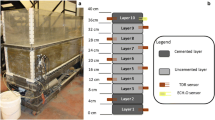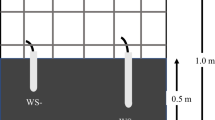Abstract
Ore treatment and processing generate large quantities of finely milled mine tailings. They are generally stored as conventional slurry in surface impoundments. Several problems could occur during tailings deposition such as: (i) risks of physical instability of dams, (ii) chemical instability due to sulfide oxidation, and (iii) environmental footprint due to land use and wasted water. Exposition of tailings to atmospheric water and oxygen accelerates sulfide oxidation, and consequent carbonate dissolution can lead to acid mine drainage formation. The objectives of this study were to evaluate the effectiveness of surface paste disposal combined with the use of cementitious amendments to solidify/stabilize acid-generating tailings. The studied tailings were characterized for their physical, chemical, and mineralogical properties. Two field cells (cemented cell and uncemented reference cell) were constructed at the operating LaRonde mine (Quebec, Canada) to investigate the long-term hydro-geochemical effectiveness of cemented surface paste disposal to limit tailings’ reactivity. The cells, which were inverted truncated pyramids (up to 800 m3), were equipped with suction and water content probes. The chemical and mineralogical composition of the mine tailings revealed high sulfide content, mainly as pyrite, of about 29 wt%. Carbonates (acidity buffers) occurred at low content (around 0.1 wt%). The addition of cement within surface paste disposal reduces water infiltration and consequently contact surface and time between reactive tailings and water. Moreover, the geochemical behavior of cemented and uncemented cells was relatively similar at the beginning of the tests. pH values were circumneutral around 7 and electrical conductivity ranged between 1 and 8 ms/cm. Considering metal(oid)s, uncemented cells showed higher release for Al, As, Fe, Cd, Co, Ni, S, and Zn. This means promising results of using cemented surface paste disposal to limit contamination from these sulfidic tailings when runoff is integrated into the concept. However, pH values dropped down at the fifth year of the hydro-geochemical monitoring, but the metal(oid)s stabilization was successfully achieved. The main mechanisms responsible for metal(oid)s attenuation were precipitation of secondary phases such as iron oxy-hydroxides and/or contaminant physical trapping.
Access this chapter
Tax calculation will be finalised at checkout
Purchases are for personal use only
Similar content being viewed by others
References
Benzaazoua, M., et al. (2004). A laboratory study of the behaviour of surface paste disposal. In Proceedings of the 8th International Symposium on Mining with Backfill, The Nonferrous Metals Society of China, Beijing.
Cravotta III, C. A. (2008). Dissolved metals and associated constituents in abandoned coal-mine discharges, Pennsylvania, USA. Part 2: Geochemical controls on constituent concentrations. Applied Geochemistry, 23(2), 203–226.
Elghali, A., et al. (2019). In Situ effectiveness of alkaline and cementitious amendments to stabilize oxidized acid-generating tailings. Minerals, 9(5), 314.
Tuylu, S., Bascetin, A., & Adiguzel, D. (2019). The effects of cement on some physical and chemical behavior for surface paste disposal method. Journal of Environmental Management, 231, 33–40.
Author information
Authors and Affiliations
Corresponding author
Editor information
Editors and Affiliations
Rights and permissions
Copyright information
© 2023 The Author(s), under exclusive license to Springer Nature Switzerland AG
About this paper
Cite this paper
Elghali, A., Benzaazoua, M., Maqsoud, A. (2023). Cemented Surface Paste Disposal as a Mine Tailings Management Scenario: In Situ Long-Term Hydro-Geochemical Behavior Using Field Experiments. In: Kallel, A., et al. Selected Studies in Environmental Geosciences and Hydrogeosciences. CAJG 2020. Advances in Science, Technology & Innovation. Springer, Cham. https://doi.org/10.1007/978-3-031-43803-5_30
Download citation
DOI: https://doi.org/10.1007/978-3-031-43803-5_30
Published:
Publisher Name: Springer, Cham
Print ISBN: 978-3-031-43802-8
Online ISBN: 978-3-031-43803-5
eBook Packages: Earth and Environmental ScienceEarth and Environmental Science (R0)




